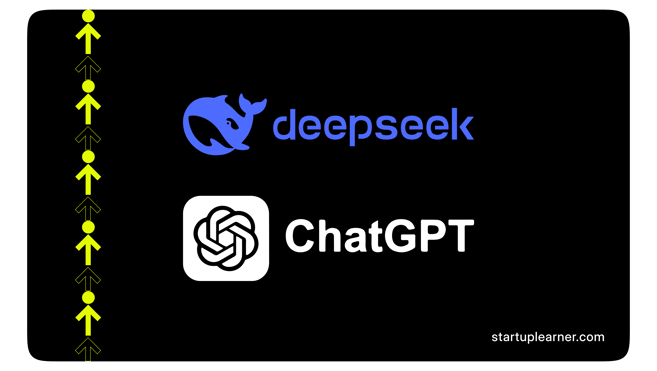How DeepSeek R1 is Shaping the Future of AI Innovation
AI
Startup Learner
4/9/20254 min read



How DeepSeek R1 is Shaping the Future of AI Innovation
Introduction
In the rapidly evolving landscape of artificial intelligence, the release of DeepSeek R1 has captured the attention of researchers, developers, and startup founders worldwide. Developed by the Chinese AI company DeepSeek, R1 is an open-source reasoning model that demonstrates performance comparable to OpenAI’s GPT-4o — but at a fraction of the cost.
Beyond the hype, DeepSeek R1 offers a glimpse into the future of AI innovation: one driven by smarter training methods, greater accessibility, and relentless focus on efficiency.
In this blog, we’ll explore what makes DeepSeek R1 unique, the breakthroughs it brings to AI development, and why it signals a new era of opportunity for entrepreneurs and builders.
What is DeepSeek R1?
To understand DeepSeek R1, it’s important to differentiate two models:
DeepSeek V3: A general-purpose base model, released in December 2024, designed to be comparable to other flagship models like OpenAI’s GPT-4, Anthropic's Claude 3.5, and Google's Gemini 1.5.
DeepSeek R1: A specialized reasoning model built on top of V3, optimized specifically to perform complex step-by-step problem-solving, much like OpenAI’s GPT-4o’s advanced reasoning.
While V3 provides a solid foundation, R1 represents a significant leap forward in how AI models are trained to think through problems — and not just generate responses.
Key Innovations Behind DeepSeek R1
DeepSeek’s rise has not been accidental. Several deliberate innovations have powered R1’s success:
1. Training Efficiency with FP8 Precision
DeepSeek optimized the training of its models by using 8-bit floating point (FP8) precision instead of the traditional 16-bit or 32-bit.
This resulted in massive memory savings without compromising model quality.
A clever technique called FP8 accumulation fix periodically merged calculations into higher-precision formats to prevent errors, enabling faster and cheaper model training across thousands of GPUs.
2. Mixture of Experts (MoE) Architecture
DeepSeek V3 uses a Mixture of Experts model with 671 billion parameters — but activates only 37 billion at a time.
This leads to 11x fewer parameters being used for each prediction compared to traditional models.
MoE dramatically reduces computation costs while maintaining high-quality outputs.
3. Advanced Memory Optimization: Multi-Head Latent Attention (MLA)
Handling memory efficiently is critical for large models.
DeepSeek introduced MLA, a way to compress and reconstruct key-value pairs dynamically during model operation, reducing memory usage by 93% and boosting generation throughput significantly.
4. Multi-Token Prediction (MTP) for Better Planning
Instead of predicting one token at a time, DeepSeek’s models predict multiple future tokens simultaneously.
This improves training efficiency and creates smoother, more coherent outputs.
It also accelerates inference, making models faster in real-world applications.
How DeepSeek R1 Masters Reasoning
While most language models can be prompted to think "step-by-step," R1 is fundamentally trained to reason through problems — not just react.
Here’s how DeepSeek built R1’s reasoning ability:
Reinforcement Learning (RL):
R1 was trained using reinforcement learning on datasets of complex problems (especially math and coding tasks), optimizing for correct final answers rather than mimicking human examples.Simple Reward Systems:
Instead of complicated feedback, R1’s training rewards were based on basic accuracy and formatting rules. This lightweight system allowed faster and more scalable training.Group Relative Policy Optimization (GRPO):
DeepSeek introduced a novel training technique called GRPO — enabling the model to improve its thinking quality through thousands of reinforcement learning steps.Cold Start Phase:
To avoid issues like random language switching (English and Chinese mixing), DeepSeek added a cold-start fine-tuning phase using structured examples, improving R1’s clarity and coherence.
The result?
R1 can think deeply, backtrack when wrong, and plan multi-step solutions — skills traditionally hard to achieve in general-purpose language models.
Why DeepSeek R1 Matters
The release of R1 is not just another milestone. It represents several important shifts:
1. Cost Efficiency at Scale
DeepSeek claims to have trained V3 (the base model) for around $5.5 million — far cheaper than previous frontier models.
While this figure excludes hardware and R&D costs, it shows that next-gen AI no longer requires billion-dollar budgets.
2. Open Access and Democratization
Unlike many Western labs, DeepSeek open-sourced its models.
You can download, run locally, and even fine-tune DeepSeek models.
This lowers the barrier for startups, researchers, and developers to experiment with top-tier AI.
3. Proof That New Players Can Win
DeepSeek’s success proves that the AI frontier isn't locked down by a few big tech companies.
Smart optimizations, architectural innovation, and a focus on reasoning have created a competitive model.
New startups can now build on top of these breakthroughs without massive resources.
What This Means for Startup Founders
For early-stage founders and startup builders, DeepSeek R1 is a clear signal: this is the best time to innovate in AI.
Cheaper Intelligence:
The cost of using powerful AI models keeps dropping — making AI-enhanced products more accessible.Smarter Systems:
With reasoning models, startups can build applications that solve complex tasks: tutoring systems, coding assistants, financial modeling, legal drafting, and more.Customization Opportunities:
Open models like DeepSeek R1 enable fine-tuning on domain-specific datasets, creating highly tailored AI solutions for niches and industries.
In short: new opportunities are wide open.
Conclusion: A New Chapter in AI
DeepSeek R1 is not just another new model — it's a glimpse into the future of AI innovation.
A future where:
Training is cheaper.
Models reason better.
Open access fuels rapid iteration.
New founders have a real shot at shaping the next generation of AI products.
If you’re building or dreaming of launching an AI startup, there’s no better time than now.
The future is not just coming — it’s already here.
And it's waiting for bold builders to take the lead.


